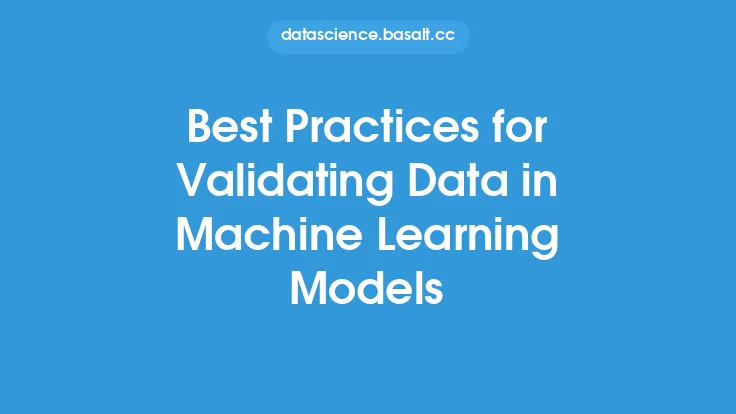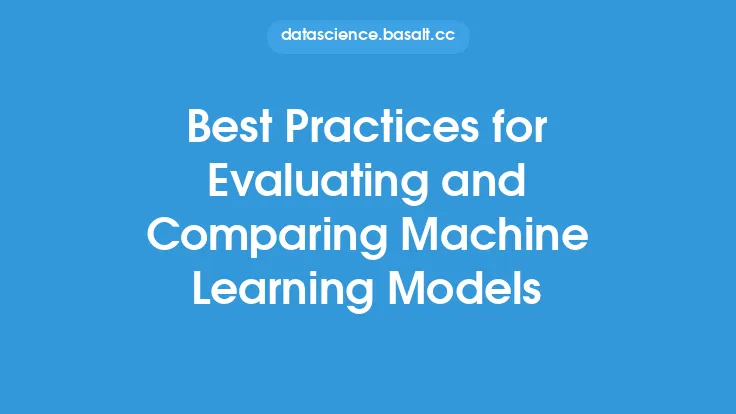When working with supervised learning, it's essential to follow best practices to ensure that your models are accurate, reliable, and generalizable. Two critical components of supervised learning are data preprocessing and model selection. In this article, we'll delve into the details of these two components, providing you with a comprehensive understanding of how to prepare your data and choose the right model for your problem.
Data Preprocessing
Data preprocessing is a crucial step in supervised learning, as it can significantly impact the performance of your model. The goal of data preprocessing is to transform your raw data into a format that's suitable for modeling. Here are some key steps to follow:
- Handling missing values: Missing values can be a significant problem in supervised learning, as they can lead to biased models or poor performance. There are several strategies for handling missing values, including mean imputation, median imputation, and imputation using a regression model.
- Data normalization: Data normalization is the process of scaling your data to a common range, usually between 0 and 1. This can help improve the stability and performance of your model, as some algorithms are sensitive to the scale of the data.
- Feature scaling: Feature scaling is similar to data normalization, but it's applied to individual features rather than the entire dataset. This can help prevent features with large ranges from dominating the model.
- Encoding categorical variables: Categorical variables, such as text or categorical labels, need to be encoded into a numerical format that can be processed by the model. Common encoding techniques include one-hot encoding, label encoding, and binary encoding.
- Removing outliers: Outliers can significantly impact the performance of your model, as they can lead to biased estimates or poor generalization. There are several techniques for removing outliers, including winsorization, trimming, and robust regression.
Model Selection
Model selection is the process of choosing the best model for your problem. There are many different models to choose from, each with its strengths and weaknesses. Here are some key factors to consider when selecting a model:
- Model complexity: Model complexity refers to the number of parameters or features used by the model. More complex models can capture more subtle patterns in the data, but they can also be prone to overfitting.
- Model interpretability: Model interpretability refers to the ability to understand and explain the predictions made by the model. Some models, such as linear regression and decision trees, are highly interpretable, while others, such as neural networks, can be more difficult to interpret.
- Model performance: Model performance refers to the accuracy or error rate of the model. There are many different metrics for evaluating model performance, including mean squared error, mean absolute error, and classification accuracy.
- Computational resources: Computational resources refer to the amount of time and memory required to train and deploy the model. Some models, such as neural networks, can require significant computational resources, while others, such as linear regression, can be much faster and more efficient.
Evaluating Model Performance
Evaluating model performance is a critical step in supervised learning, as it allows you to compare the performance of different models and choose the best one for your problem. Here are some key metrics for evaluating model performance:
- Mean squared error (MSE): MSE is a common metric for evaluating the performance of regression models. It measures the average squared difference between the predicted and actual values.
- Mean absolute error (MAE): MAE is another common metric for evaluating the performance of regression models. It measures the average absolute difference between the predicted and actual values.
- Classification accuracy: Classification accuracy is a common metric for evaluating the performance of classification models. It measures the proportion of correctly classified instances.
- Precision and recall: Precision and recall are two related metrics that are commonly used to evaluate the performance of classification models. Precision measures the proportion of true positives among all positive predictions, while recall measures the proportion of true positives among all actual positive instances.
- F1 score: The F1 score is a metric that combines precision and recall into a single score. It's commonly used to evaluate the performance of classification models.
Hyperparameter Tuning
Hyperparameter tuning is the process of adjusting the hyperparameters of a model to optimize its performance. Hyperparameters are parameters that are set before training the model, such as the learning rate, regularization strength, and number of hidden layers. Here are some key techniques for hyperparameter tuning:
- Grid search: Grid search is a technique that involves searching through a grid of possible hyperparameters to find the optimal combination.
- Random search: Random search is a technique that involves randomly sampling the hyperparameter space to find the optimal combination.
- Bayesian optimization: Bayesian optimization is a technique that involves using a probabilistic model to search for the optimal hyperparameters.
- Gradient-based optimization: Gradient-based optimization is a technique that involves using gradient descent to search for the optimal hyperparameters.
Cross-Validation
Cross-validation is a technique that involves splitting the data into training and testing sets to evaluate the performance of a model. Here are some key types of cross-validation:
- K-fold cross-validation: K-fold cross-validation involves splitting the data into k folds and training the model on k-1 folds while evaluating its performance on the remaining fold.
- Leave-one-out cross-validation: Leave-one-out cross-validation involves training the model on all but one instance and evaluating its performance on the remaining instance.
- Stratified cross-validation: Stratified cross-validation involves splitting the data into training and testing sets while maintaining the same class distribution in both sets.
By following these best practices for data preprocessing, model selection, model evaluation, hyperparameter tuning, and cross-validation, you can develop accurate and reliable supervised learning models that generalize well to new, unseen data. Remember to always explore your data, evaluate your models carefully, and consider multiple models and techniques to find the best approach for your problem.





